Potential Prevention Strategy for Exercise Associated Muscle Cramps
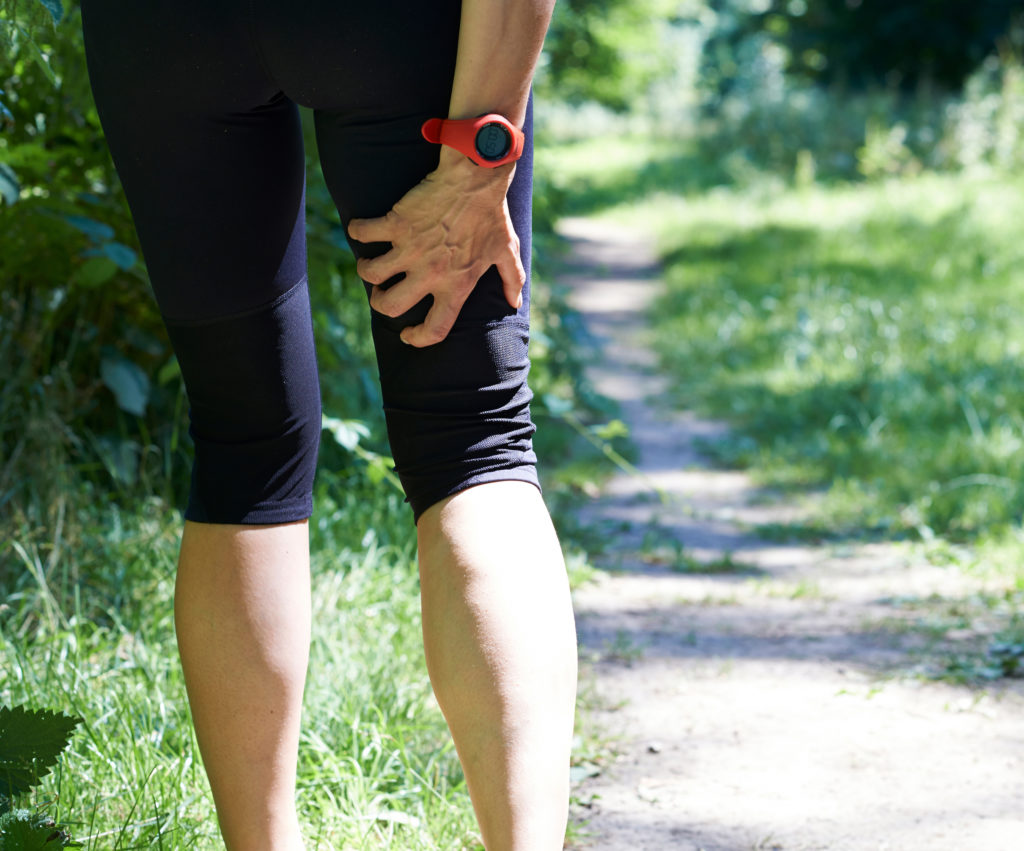
Exercise associated muscle cramp (EAMC) is a painful, spasmodic, and involuntary contraction of muscle that occurs during or immediately after exercise.
The exact mechanism or cause of EAMC still remains unclear.
There is a consensus the first aid treatment of EAMC is to stretch the affected muscle. However, Coppin and colleagues conclude that regular stretching exercise fails to prevent cramping. There is no clear strategy to prevent EAMC (Hawke, F 2012).
There are two hypotheses of why EAMC occurs.
Electrolyte depletion and dehydration hypothesis: The cramp is due to the change/decrease in hydration and serum electrolyte status induced by exercise. The evidence for this hypothesis is mainly anecdotal. One of the criticisms of this hypothesis is heat cramping may be a separate problem from EAMC. Dehydration and electrolyte imbalance are systemic abnormalities, it is not clear how these changes would result in local symptoms of a specific muscle cramping (Jahic, D – 2018). Muscle cramping can occur without dehydration and electrolyte imbalance.
Altered neuromuscular control hypothesis: The cramping is in response to abnormal spinal reflex activity. Muscle cramps occur when the muscle is a position of shortened length (Bertolasi, L 1993).
An example of a spinal reflex is taping the tendon of the knee with a reflex hammer and the knee-jerking into movement. The quick tap of the tendon stimulates the specialized sensory nerves in the muscle and tendons. The muscle cramp hypothesis is there is an Imbalance between signals coming from sensory nerves in the muscle (muscle spindle) to the spinal cord and a decrease in nerve signals coming from the spinal cord back to the muscle which inhibits the muscle contraction (Golgi tendon organ). The imbalance in spinal reflex leads to a muscle cramp. It is recognized this spinal reflex resulting in a muscle cramp occurs when the muscle is contracting when it is in a shortened (slackened) position.
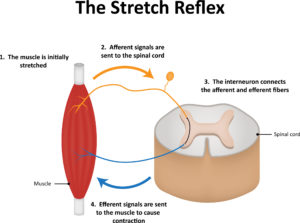
The length-tension relationship of a muscle is the relationship between muscle length and the tension/force the muscle can produce at that length. The length of a muscle-tendon unit can vary from a long length to short or slack length. More tension/force is occurring when the muscle is neither long (lengthen) or short (slack). Less tension/force occurs when the muscles are lengthened or slackened. The illustration below shows this relationship.

Interestingly, exercise associated muscle cramps only seem to occur when the muscle is contracting when in a shortened or slackened position.
Muscles in the lower extremity which are notorious for cramping are the rectus femoris (thigh); hamstring; calf; and foot muscles. These are muscles that cross two or more joints and produce simultaneous movements at all the joints they cross. This can result in a position of slack at which the muscle can no longer generate a useful amount of force. This is muscle active insufficiency. When actively contracting the muscle is insufficient at producing useful force.
Positions of active insufficiency for muscles susceptible to cramping
The position of active insufficiency for the rectus femoris is hip flexion with knee extension. This is commonly described as isometric knee extension, straight leg raise performed in sitting. Another description is L sit or V sit position.
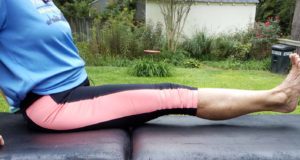
The position of active insufficient of the hamstring muscle is hip extension with knee flexion. Yoga instructors call this the “twisted lizard pose”. A simpler description is a hamstring curl. Standing or kneeling thigh stretch without using the hands is a position of active insufficiency for the rectus femoris – see below.
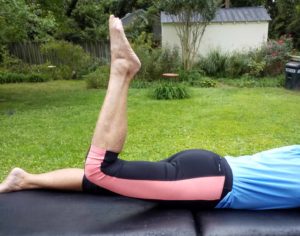
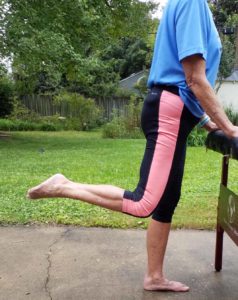
The position of active insufficiency for the calf muscle is knee flexion with plantar flexion of the ankle, foot, and toes. This would be described as the flutter kick but the knee is flexed. Standing active heel raise while keeping the knee flexed is active insufficiency of the calf muscles.

The position of active insufficiency for the foot muscles is ankle plantar flexion and plantar flexion of the toes. This ballet pointe position or the flutter kick swimming – see below
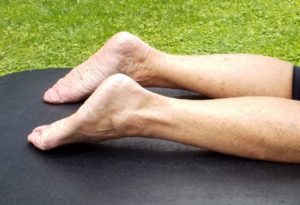
A potential strategy to prevent exercise associated muscle cramps:
If contracting or engaging a muscle when it is a position of active insufficiency elicits cramps it suggests a possible prevention strategy.
One strategy is to avoid or minimize the position of active insufficiency during hard long exercise periods. There are times when this is not possible. Athletes swimming long distances need to place the foot and calf muscle is a position of significant slack when performing flutter kick. The flutter kick is a position of active insufficiency for ankle and foot muscles.
Another strategy is to is train and strengthen the muscle at risk for cramping in the position of active insufficiency.
Behringer and colleagues propose muscles can be stronger in a manner which can prevent EAMC. The investigators used electrical stimulation of muscles to induce muscle cramps. The subject’s calf muscle was in a slack position (active insufficiency position). The procedure to elicit muscle cramps was done 2 times a week for 6 weeks. The result is after 3 weeks and 6 weeks it took significantly more electrical stimulation to trigger a muscle cramp. It was more difficult to trigger a muscle cramp. In two subjects they were no longer able to artificially elicit a muscle cramp after training. The threshold to elicit cramps changed.
Essentially, they applied a colloquial saying “Drink the hair of the dog”. Meaning the best cure for what ails you is to have some more of it. In ancient times it was literally used to say that if a dog were to bite you, putting hair of the dog in the wound will heal it.
The procedure In Behringer’s experiment to train the muscles were relatively complex and not clinically applicable in that it uses electrical stimulation of calf muscles.
The exciting part of Behringer’s research is it suggests a procedure to prevent EAMC.
Perhaps adding routine isometric strengthening exercises to muscles that are susceptible to cramping can change the frequency of troublesome ECAM.
A potential working hypothesis is If the muscles at risk of experiencing EACM perform regular isometric strengthening exercise with the muscle in a position of active insufficiency, then it will decrease the likelihood of EACM. This deserves investigation.
While there is a correlation between the active contraction of a muscle in a slackened position with the onset of EACM the pathophysiological mechanism or why is, yet to be determined.
Bottom line:
- Causes of exercise associated muscle cramps are uncertain and likely multi-factorial
- Contraction of muscles which cross two joints in a position of active insufficiency (slackened position) is a significant risk factor for exercise associated muscle cramps
- Potential actions to prevent exercise associated muscle cramps is to include regular isometric strengthening exercise of muscles in a position of active insufficiency (slackened position).
The information on this website is not intended or implied to be a substitute for professional medical advice, diagnosis, or treatment. You are encouraged to perform additional research regarding any information contained on available through this website with other sources and consult with your physician.
Damien Howell Physical Therapy – 804-647-9499 – Fax: 866-879-8591 At-Home, At Office, At Fitness Facility – I come to you, I do home visits Damien@damienhowellpt.com
